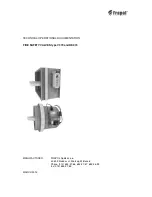
The axis of the opening made must be in the axis of the ventilation duct installed.
4.2.2. Requirements for the size and shape of openings for valve installation in the wall of cardboard-
plaster boards.
For rectangular valves RK370
For round valves V370
4.3.
PRINCIPLES FOR INSTALLATION OF FIRE VALVES
4.3.1. Assembly of the valves must correspond to one of the installation variants acc. to section 4.4.
4.3.2. The partition’s rotation axis can be horizontal or vertical for V370 valves.
4.3.3. Air flow direction via the valve is of no significance for its assembly method (before or after the
partition).
4.3.4. Valves in standard version cannot be exposed to weather conditions or chemically aggressive
environment.
4.3.5. Valve installation can be performed in a vertical fire barrier.
4.3.6. The applied assembly materials and the suspension method must prevent unintentional
change of the valve position against the fire barrier.
4.3.7. The valve must be connected to the ventilation installation without any tensions, in a durable
and leak-proof manner.
4.3.8. In the closed position, the partition must adhere to the resistance angle bars inside the casing
on the entire circumference.
4.3.9. On both sides of the valve partition inside the ventilation duct, there must be free space to
allow for its opening.
4.3.10. Electrical installation of the signalisation and powering of the drive elements must be made
according to the schematic diagrams for the relevant valve version, according to section 4.5.
4.3.11. After installation of the element in the fire barrier (depending on the version, valve or duct),
sealing must be provided between the fire barrier and the element installed, according to the
adopted version. After sealing, check for correct operation of the valve and whether the
elements of the valve drive have not become dirty. If so, clean them.
4.3.12. After installation of the fire valve and test operation, perform the commissioning confirmed with
acceptance document.
CAUTION:
When assembling joint valves (valve batteries), apply all the same principles as for single
valves.
4.4.
FIRE VALVE INSTALLATION VARIANTS.
Depending on the designed valve situation as regards the fire barrier, there are the following
installation variants:
-
in the fire barrier,
-
remote from the fire barrier.
A special case of valve situation against the fire barrier is the installation on the surface of the barrier.
For fire barrier class EI120, required thickness “G” amounts to:
Bearing profile
plaster wall
Bearing profile
plaster wall
Plaster boards
Plaster boards






































